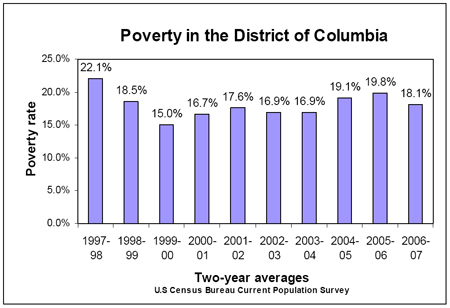New poverty data from the U.S. Census Bureau present some contradictory findings on economic trends in the District of Columbia, according to an analysis by the DC Fiscal Policy Institute, although the data show that poverty has not improved since the end of the last recession in 2001.
One of two Census Bureau surveys released today indicates that that poverty fell sharply in the District of Columbia in 2007, led by an especially steep drop in child poverty. A second Census Bureau survey, by contrast, shows that poverty did not change by a statistically significant margin.
Both surveys, however, show that poverty in DC in 2007 was about the same as in 2001, the end of the 1999-2001 recession. This suggests that the District’s strong economic growth in recent years has not translated into improvements for its lowest income residents. The failure to reduce poverty during a period of growth is troubling, particularly as new signs emerge that the city’s economy may be slowing down as part of national economic trends.
- Data from the Census Bureau’s American Community Survey show poverty in DC fell from 19.6 percent in 2006 to 16.4 percent in 2007, reflecting a drop of 16,000 in the number of poor residents. The ACS data show that the child poverty fell by almost one-third, from 32 percent to 22 percent. (No state or major city saw poverty declines anywhere close to this level.)
- Data from the Census Bureau’s Current Population Survey shows that poverty fell from 19.8 percent in 2005-2006 to 18.1 percent in 2006-2007, a change that was not statistically significant. (The Census Bureau recommends using two-year averages with this data set.)
- The poverty rate in 2001 was between 17 percent and 18 percent in both surveys.

The decline in poverty reported in the ACS data is mysterious because there are no other data to suggest that poverty would fall by this magnitude. Wages for the low-wage jobs in the city increased by less than three percent in 2007 (after adjusting for inflation), and the unemployment rate fell only modestly, from 5.9 percent to 5.7 percent. The city’s TANF caseload fell by fewer than 800 families with children, or 5 percent.
Moreover, the Census data are for 2007 and therefore do not reflect the impact of the recent economic downturn. The unemployment rate in DC has risen since April 2008 and reached 7.2 percent in July, the highest level since February 2005. The Census data also do not take into account the impacts on family budgets of soaring food and energy costs this year, which fall especially hard on those who did not benefit from recent prosperity of the earlier part of this decade.
These findings reinforce the importance of services that help low-income DC residents address the very high costs of living in the city – including assistance with housing, energy, and food costs – as well as supports for residents who become unemployed. The lack of progress in reducing poverty in the city also suggests that the District needs to improve job training and education services to help more residents move into jobs or into higher-paying jobs.
